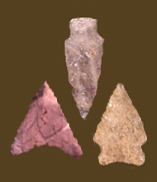
|
KIRK STEMMED
Chronology The Kirk Stemmed point dates to the Early Archaic period. Justice (1987) suggests a date range of 8900 to 8000 BP (approximately 8100-7025 BC in calendar years), while the Virginia Department of Historic Resources (www.dhr.virginia.gov) uses 8800 to 8100 (7850-7075 BC) BC. Broyles (1971) dates this type to around 8800 BP (7850 BC), based on excavations at the St. Albans site in Kanawha County West Virginia, and McAvoy and McAvoy (1997) place it at 8700 BP (7600 BC) along the Nottoway River in Virginia. Custer (1996a) says that the Kirk Stemmed date range in Delaware and the surrounding region appears to be 8200 to 8000 BP (7250-7025 BC). At the stratified UMBC site in Baltimore County, Maryland, Kirk Stemmed points were found above LeCroy and Kanawha Stemmed types (Vitelli 1975). Dent (1995) describes the long date range of the Kirk Stemmed as “problematic,” with some radiocarbon assays pushing it into the Middle Archaic period. Coe (1964) puts the point chronologically between Kirk Corner Notched and Kirk Serrated types. At the stratified Pig Point site in Anne Arundel County, Maryland, a heavily re-sharpened possible Kirk Stemmed point was recovered in a layer with two hearths that produced three radiocarbon dates ranging from 7530 +/- 50 BP to 7290 +/- 50 BP, or approximately 6400-6200 BC (Luckenbach 2011a). This is considerably younger than expected, but in the Northeast radiocarbon dates have been reported that suggest that many Early Archaic point types there are as much as 1500-2000 years younger than their equivalents in the Southeast (Funk 1993; Kent 1996). Description Blade: The blade is long, narrow, and thick, with straight or incurvate edges, the result of resharpening. Usually the edges are concave toward the base, then re-curve toward the tip. Serrations are deep, especially in the concave area. Haft Element: The base may be straight or slightly rounded, or occasionally slightly concave. Broad, shallow notches produce a stem that expands slightly toward the base, and shoulders that project slightly backward. Size: Length ranges from 45 to 150 mm, with an average of 100 mm. Width ranges from 25 to 50 mm, with an average of 35 mm. Thickness ranges from 6 to 15 mm, with an average of 10 mm. Technique of manufacture: The basic blade appears to have been made with broad, shallow percussion flakes, followed by pressure flaking to shape the edges. The serrations were made as a final step. Material: In a sample of 36 Kirk Stemmed points from the lower Patuxent drainage, Steponaitis (1980) reported that 45% were rhyolite, followed by quartzite (23%), quartz (18%), jasper (6%), and chert (3%). In the area surrounding Zekiah Swamp on the lower Potomac, Wanser (1982) found that 46% of 59 Kirk Stemmed points were quartz, with 29% rhyolite, 22% quartzite, and 3% other material. The seven Kirk Stemmed points excavated at the stratified UMBC site in Baltimore County were all rhyolite (Vitelli 1975). In the Monocacy River drainage, 59% of Kirks (all types) are rhyolite (Kavanagh 1982), while chert is the predominate material in the middle Potomac River Valley (Hranicky 2002). In the Hagerstown Valley, a majority of Kirk points were rhyolite (particularly in the eastern areas closest to rhyolite quarries), followed by lesser amounts of chert, quartzite, and jasper (Stewart 1980). In Western Maryland, Kirk points are commonly made from local and non-local cherts, as well as siltstone and occasionally rhyolite (Wall 1991, 1992). In Delaware, approximately 75% of Kirk Stemmed points are rhyolite, followed by quartzite (Custer 1996a). Discussion Defined in Literature Coe (1964) originally defined the type based on points recovered from the Hardaway site in North Carolina. Broyles (1971) also discusses this type based on points recovered from the St. Albans site in West Virginia. References |
![]()
Search by Shape:
(See Projectile Point Typology) |

|
Thank you for visiting our website. If you have any
questions, comments, Copyright © 2002 by |

|

 Defining Attributes
Defining Attributes